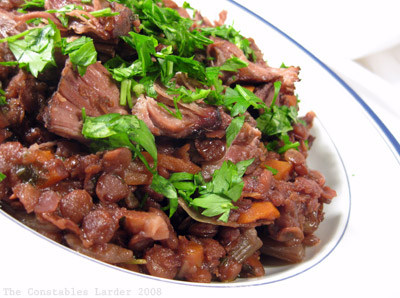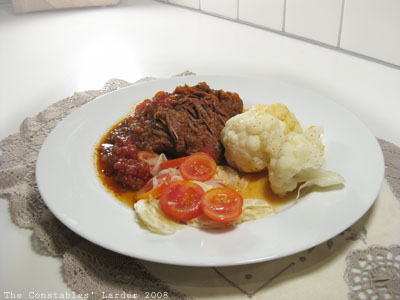When my friend John gave me two Mark Bittman cookbooks (I retaliated by giving him the Dean & Deluca cookbook and Jamie Oliver’s Naked Chef), I was looking forward to expanding my stylistic horizons through The Best Recipes in the World. Needless to say, John nearly fell over laughing when I told him that the first recipe I tried from the cookbook was… French. Gee, way to wander from your norm! Well, I didn’t have bloody pasilla chiles lying around John!! (but boy that recipe looked good), however I did have lentils!
This dish is like the classic daubes I learned to make from Julia Child’s Essentials of French Cooking years ago, only simpler. I changed Bittman’s recipe a fair amount to suit my purposes, but I’ll definitely credit the cookbook for reminding me of this great dish I haven’t made in a while. I called it a “drunk” braise because you sacrifice a bottle of red to the cause!
Serves 4
4 lamb loin chops (can do this recipe with beef instead if you aren’t a lamb fan)
3 medium carrots, peeled and chopped
1 onion, chopped
1 fennel bulb, chopped
3/4 lb dried green lentils (picked over to watch for small stones)
1 handful small orange lentils (optional)
1 tbsp minced garlic
3 medium bay leaves, or 2 large
1 large handful of chopped parsley
1 bottle of red wine (I used a zinfindel)
water
salt and pepper
olive oil
Preheat oven to 320F
Heat some olive oil in a dutch oven over medium high heat and sear your lamb for about 20-30 seconds each side and remove to a side plate.
In your dutch oven, bring the heat down to medium-low and saute your chopped onion and garlic until the onion starts to turn translucent, and then add the chopped carrots, fennel, parsley, lentils, bay leaf, half a tsp of salt, a few grindings of pepper, and the bottle of wine and turn up the heat until it is bubbling.
Nestle the lamb into the mix, cover, and place in the oven for 3 to 3.5 hours. Check the pot every 45 minutes or so and very gently stir. Flip the lamb halfway through. If it is simmering a little too hard at any point, lower the heat another 15F. If the dish starts to dry out (you want it to be nicely moist), add water. I would estimate I ended up adding about a cup of water. It is also important to taste for salt — too much will ruin this dish, but too little will leave this quite flat.
I served by removing the lamb to a cutting board, and shredding the meat with two forks. I then layered it on top of the lentils and vegetables, topped with some fresh parsely. This goes well with a red wine with some body, or a dark beer.
: : :
So that’s the normal recipe. In full disclosure, I’ll note that in this particular case, I started it two nights ago and cooked it for two hours (it wasn’t going to be done in time for dinner that night), and then placed in the fridge until I was able to finish and serve it tonight. Not wanting to put my dutch oven in the fridge, I shifted everything carefully to a deep baking dish. Tonight when finishing the cooking process, I didn’t want to make more washing up so I left it all in the baking dish, covered that with aluminum foil, and cooked it for another hour and a half tonight at 280F.
I love slow, low heat cooking probably more than anything.


